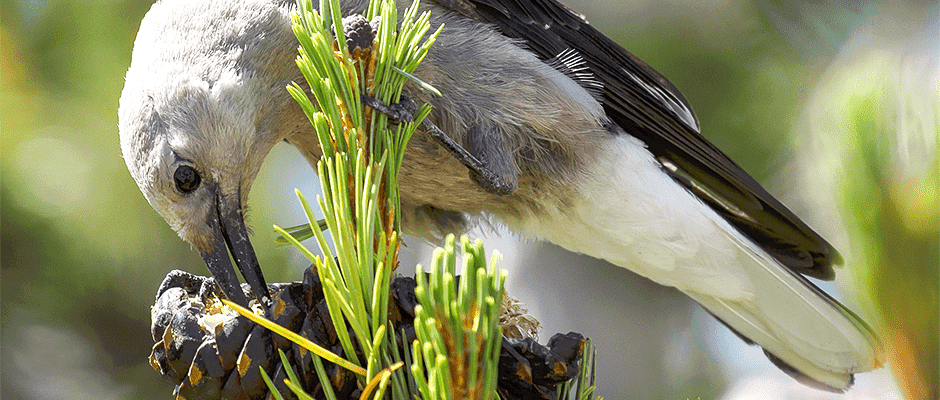Share this article
Best Friends Forever – from The Wildlife Professional
It’s late fall in the high mountains of western North America and the whitebark pine (Pinus albicaulis) forests are alive with activity. Birds and mammals are feasting on the pine’s copious amounts of large seeds. When the cones ripen, the competition for the fatty, nutritious seeds — which contain “more energy than chocolate per unit of weight” according to the Cornell Laboratory of Ornithology — is a sight to see.
Among the important wildlife species that consume the seeds is the iconic grizzly bear (Ursus arctos). Highly dependent on the pine seeds, the grizzly population in the Greater Yellowstone Ecosystem thrives when the cone crop is good. Local management agencies even conduct extensive annual cone survey transects to measure the crop size and adjust their grizzly bear management plans based on the size of the crop.
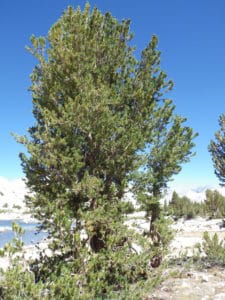
The whitebark pine comprises 10 to 15 percent of total forest cover in the lower timberline areas of the Northern Rocky Mountains. ©USDA NRCS Montana
While the grizzly bear may be the largest species that covets the seeds, over 110 species of animals compete for them in many parts of the tree’s range. That’s why scientists often describe whitebark pine forests as “keystone” or “foundation” ecosystems in these high mountain settings. If the tree is lost, so too is an important food source for many wildlife species.
Sadly, whitebark pine trees are dying at astounding rates across the species’ range, and the seed crops from this keystone ecosystem are dwindling rapidly (Keane et al. 2012). The decline is so bad that the pine is a candidate species under the federal Endangered Species Act; however, it’s currently precluded from listing due to administrative backlogs.
One bird in particular, the Clark’s nutcracker (Nucifraga columbiana), functions as the main dispersal vector for whitebark pine seeds. It’s a story of a unique mutualistic relationship that is in trouble.
Whitebark pine characteristics
Whitebark pine is a five-needled pine that is distributed from timberline to lower subalpine regions in the northern and central Rocky Mountains, Cascade Range and in portions of the Sierra Nevada range in the United States and Canada (Keane et al. 2012). It’s unique among pines because it’s not used for commercial timber or pulp. The tree’s value lies in its seed crop.
Over its range, the whitebark pine typically occupies about 8 to 12 percent of the landscape, ranging from the upper subalpine to timberline regions of these mountain ranges. In most upper subalpine settings, this shade-intolerant species is eventually replaced over centuries by a suite of shade-tolerant competitors, namely subalpine fir (Abies lasiocarpa), spruce (Picea engelmannii) and, in some places, mountain hemlock (Tsuga mertensiana). However, in lower timberline areas, whitebark pine is typically the dominant tree species. This lack of competition creates the idyllic open stands often enjoyed by high-elevation hikers and bird enthusiasts.

The Clark’s nutcracker’s heavy, hooked bill helps it excavate seeds from the cones of the whitebark pine. ©Robert Keane/USFS
Whitebark pine typically produces a good cone crop every three to five years. The highly visible cones are bright purple and arranged upwards at the end of branches. The seeds are large and wingless, with no vestige of a wing. Curiously, the cones rarely open, and even if they did, the round seeds would drop directly below the crown and be eaten quickly by rodents. All of these distinctive characteristics allow the Clark’s nutcracker to easily find the cones and harvest the seeds from them.
Clark’s nutcracker
The Clark’s nutcracker is an extremely intelligent bird in the corvid family, a relative of jays and crows. Smaller than a crow and slightly larger than a jay, Clark’s nutcrackers range across much of the mountainous western United States and southwestern Canada and are highly dependent on several five-needle pine species for food, including whitebark pine, limber pine (Pinus flexilis) and southwestern white pine (Pinus strobiformis).
As the only mechanism for whitebark pine seed dispersal, the Clark’s nutcracker has several adaptations that promote its mutualism with the pine, including unique behavior, physiology and anatomy optimized for foraging on the pine seeds. It’s the only bird that has a hole under its tongue leading to a sublingual pouch where it can carry a large number of seeds, often over 50. The bird’s heavy, hooked bill is also well-suited for prying seeds out of cones.
But of all the bird’s adaptions, the most impressive is its high level of intelligence as demonstrated by a very strong spatial memory. After collecting a pouchful of seeds, nutcrackers fly across vast landscapes and select distinctive places to store their seeds. The bird typically buries one to 15 seeds in a “cache,” which is about one to two centimeters deep. A typical Clark’s nutcracker will make 10,000 to 20,000 caches annually and recovers between 50 to 80 percent of the seeds, depending on the size of the cone crop and the energy needs of the bird. This leaves a large portion of cached seeds free to germinate and create the whitebark pine forests of tomorrow.
While the birds store seeds across the entire landscape, they especially like to create their caches in open areas, typically burned areas that have a rich pattern of landmarks so they can recognize the location of the cache. They do not rely on magnetic fields or solar angles to find their caches. Rather, they use spatial pattern recognition, keying in on logs, rocks, and other spatial features to produce a mental map.
Typically they disperse the pine seeds within a 10 to 20 kilometer range, but observations of flights up to hundreds of miles long have been recorded (Lorenz et al. 2009). These dispersal distances are several orders of magnitude greater than the distances that wind can disperse the seed of the pine’s competitors and gives the whitebark pine a strong competitive advantage in recolonizing patches where disturbance, primarily wildfires, have opened the canopy. The sheltered microsites — especially near logs, snags and rocks — provides protection for the trees to regenerate by providing shelter from snow creep that can uproot seedlings.
A triangle of interactions
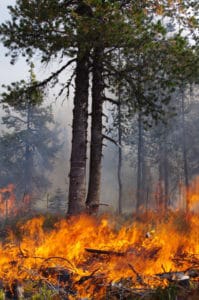
Fire creates pattern-rich, competition-free conditions that favor caching by the Clark’s nutcracker and subsequent whitebark pine regeneration and growth.
Ecologists have found an interesting relationship triangle between wildfire, which creates openings, the Clark’s nutcracker, which disperses the seeds, and the whitebark pine, which provides the seeds. Fire creates pattern-rich, competition-free conditions suitable for both nutcracker caching and subsequent whitebark pine regeneration and growth. Fire also reduces competition by killing shade-tolerant tree species, thereby creating open-canopy conditions suitable for whitebark pine growth. The birds concentrate caching in burned areas because of the rich spatial pattern left after fire (Keane 2012).
The whitebark pine has a complex fire ecology. Most forests dominated by the tree experience a mixture of three types of fire regimes: high-severity stand replacement fires, mixed-severity fires and non-lethal surface fires. Fire-return intervals vary by topography, landscape conditions and local climate and range between 80 and 500 or more years.
Lightning causes nearly all fires in high-elevation forests, usually during major seasonal droughts that occur in the driest part of the summer and early fall. Stand-replacement fires tend to be large in size and often kill more than 90 percent of the trees, creating large openings that are not readily seeded via wind dispersal from distant seed sources such as the subalpine fir and Engelmann spruce.
Whitebark pine seeds easily reach the centers of these burns, however, thanks to the Clark’s nutcracker. In mixed severity fires — which often produce a heterogeneous mosaic of canopy openings — nutcrackers place most of the cache within 0.5 to 1 kilometer from the seed source. Mixed severity burn patches from 20 to 40 hectares are optimal for nutcracker seeding because the birds prefer to place their caches within 1 to 3 kilometers of the seed source (Keane 2012).
Non-lethal surface fires maintain whitebark pine dominance by killing the shade-tolerant subalpine fir and Engelmann spruce understory. The pine survives fire better than these major competitor tree species because it has thicker bark, deeper roots and sparse crowns.
Whitebark pine decline
Complex interactions — worsened by the lack of fire and climate change — have decimated many populations of whitebark pine across its range. The decline is occurring at varying rates across many areas in the northern U.S. Rocky Mountains, causing more than 80 percent of the trees to die off in some areas (Kendall and Keane, 2001).
White pine blister rust (Cronartium ribicola) — a non-native pathogen accidently introduced to North America in 1910 from Eurasia — is rapidly becoming the greatest threat to whitebark pine that is escalating with a warming climate. The trees have little natural resistance to the rust — less than 1 percent — and since 1960, it has invaded most of the species’ range, often resulting in catastrophic die-offs.
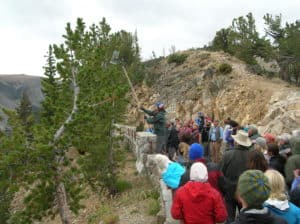
A USFS biologist demonstrates how to cage whitebark pine cones near Cody, Wyo., to protect from them from squirrel and nutcracker predation. ©Robert Keane/USFS
Multiple federal agencies, including the U.S. Forest Service and National Park Service, are working to mitigate the disease by identifying and breeding genetic variants that are resistant to blister rust, and then strategically planting them to increase native resistance levels and create resilient whitebark pine forests. Researchers also are pursuing new approaches in landscape genetics and simulation modeling to develop management solutions that increase resistance (Keane et al. 2017).
These restoration efforts are confounded by another complex interaction between the mountain pine beetle (Dendroctonus ponderosae) and whitebark pine. Scientists thought the trees’ cold habitat would slow the rate of larval development and reduce the rate of the beetle’s spread because periodic cold snaps killed nearly all larvae in large expanses of the trees’ habitat. But instead, the conditions produced low levels of the insects in most whitebark pine communities.
This dynamic has changed dramatically in the last few decades, coinciding with rapid warming of mountain ecosystems in western states. As the climate has warmed, mountain pine beetle populations have increased to outbreak levels in montane ecosystems, particularly those dominated by lodgepole pine (Pinus contorta), which has caused waves of dispersing beetles to move upslope into whitebark pine communities. The warming temperatures also have increased the susceptibility of whitebark pine ecosystems to the mountain pine beetle, accelerating the rate of larva development and greatly decreasing the frequency of die-offs from extreme cold snaps. As a result, the beetles have invaded extensive portions of the whitebark pine range, killing many of the trees.
Fire exclusion is also a threat to the whitebark pine. Without wildfire, the trees are replaced by shade-tolerant competitors in many areas of the upper subalpine. In the western U.S., federal and state agencies have followed an aggressive fire suppression policy focused on extinguishing all wildlfires since the early part of the 20th century. This management strategy has resulted in a large change in fire regimes over the last 80 to 100 years, with much lower levels and frequencies of fire in most locations.
However, since the early 2000s, the area burned by wildfires in many parts of the whitebark pine’s range has expanded greatly, likely driven by a combination of recent climate warming and the accumulation of atypical fuel loads from 100 years of fire exclusion. The increase in the number of fires may have reduced the negative impacts of fire exclusion on whitebark pine, but it also caused great concern about the future of the trees. Wildfires also kill rust-resistant whitebark pine, further facilitating the decline of the trees.
When the local abundance of whitebark pine falls, scientists also have observed a threshold effect. Instead of acting as seed dispersers, nutcrackers become seed predators, consuming nearly all cached seeds, creating a negative feedback loop of population dynamics that could wipe out local whitebark pine populations (McKinney et al. 2009.
What is being done?
The USFS, NPS, Bureau of Land Management, and several government agencies in Canada are conducting restoration activities across the range of whitebark pine in the U.S. and Canada with great success. Rust resistance levels in planted whitebark seedlings are often greater than 40 percent, and many of the areas that were burned in wildfires are now being planted with this resistant stock. Some agencies, primarily USFS, are using prescribed fire and mechanical cuttings in areas that are successionally advanced to the shade tolerant competitors.
But there is so much more to be done. Efforts are currently underway to create a local strategies and corresponding cross-agency programs for restoring whitebark pine across its range. While these efforts are laudable, the extent of the restoration needs to expand if we are to retain whitebark pine forests on the landscape. A range-wide strategy published in 2012 includes regional and project-level strategies for conserving this precious tree species, and currently, the U.S. and Canadian land management agencies are in the process of developing a comprehensive multi-national restoration plan for public lands (Keane et al, 2012).
It may take a century to see the results of current restoration efforts; but hope is that the high mountain whitebark pine forests of North America will once again be alive with activity, ensuring the pine and the bird remain best friends forever.

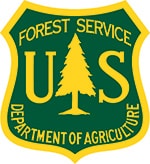 Robert E. Keane, PhD, is a research forest ecologist with the U.S. Forest Service Rocky Mountain Research Station and a TWS member.
Robert E. Keane, PhD, is a research forest ecologist with the U.S. Forest Service Rocky Mountain Research Station and a TWS member.
 Samuel A. Cushman, PhD, is a research ecologist with the U.S. Forest Service Rocky Mountain Research Station.
Samuel A. Cushman, PhD, is a research ecologist with the U.S. Forest Service Rocky Mountain Research Station.
Header Image: The Clark’s nutcracker has a mutualistic relationship with the whitebark pine, acting as the tree’s main seed dispersal mechanism. ©Marshal Hedin



